Experience Japanese Arts and Crafts in Kyoto: 12 Cultural Workshops

Discover diverse Japanese traditions by taking part in cultural workshops in Kyoto: mend ceramics with gold, enjoy a tea ceremony in an exquisite silk kimono, try your hand at incense making or dyeing textiles with seasonal plants, and more!
Japanese Culture Workhops in Kyoto
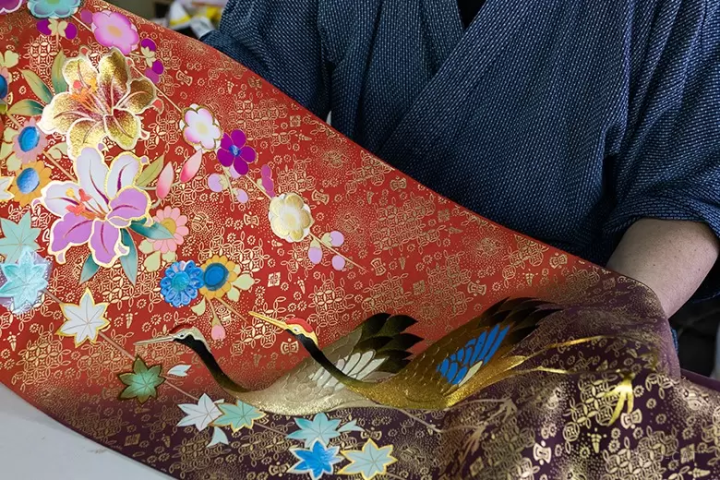
Picture courtesy of Wabunka
Japan boasts countless traditional crafts and performing arts that uniquely define its culture. From kimono, tea ceremony, and exquisite sweets to ceramics restored with gold, we have selected 12 traditional Japanese art and craft workshops that can be enjoyed in Kyoto.
Meet artisans, learn their crafts, and depart with your handmade creations as treasured mementos.
12 Cultural Workshops in Kyoto
1. Kintsugi Experience
2. Japanese Confectionery Workshop
3. Private Kimono and Tea Ceremony Experience at a Machiya Townhouse
4. Incense Making Experience with Tea Ceremony
5. Dye a Silk Scarf or Handkerchief with Seasonal Plants
6. Kyoto Roof Tile Artisanship: Private Tour
7. Make Japanese Sweets at Wagashi Issho
8. Kimono Workshop Tour and Bridal Kimono Hands-on Experience
9. Gild a Beckoning Cat and Postcard With Gold Leaf
10. Kiyomizu Ware Pottery Experience
11. Craft a Journal with Traditional Handmade Washi Paper
12. Authentic Tea Ceremony with Exclusive Treats from a Kyoto Confectioner
1. Kintsugi Experience at Shikata Urushi, a Famous Lacquerware Shop in Kyoto
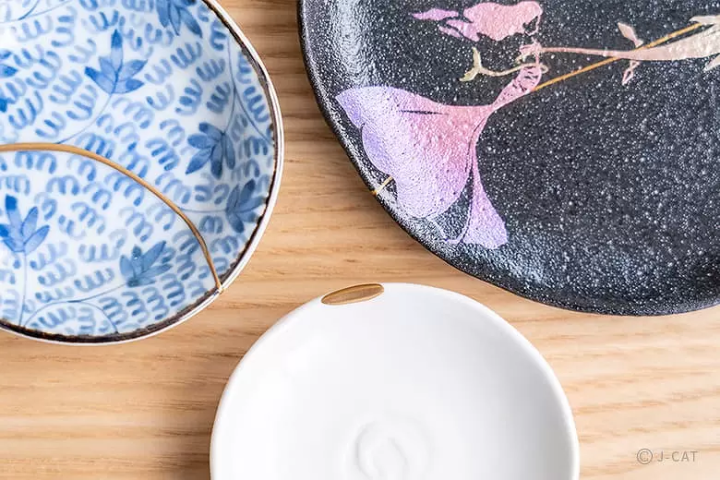
Picture courtesy of Wabunka
Kintsugi, one of Japan's most beautiful crafts, is an extraordinary tradition that has captivated people from around the world with its philosophy of embracing imperfections.
This art form involves repairing broken pottery and vessels, accentuating their scars and fractures with golden lacquer paint. Through this process, Kintsugi transforms ordinary ceramics into extraordinary pieces, celebrating flaws and adversities as elements of beauty rather than imperfections to be discarded.
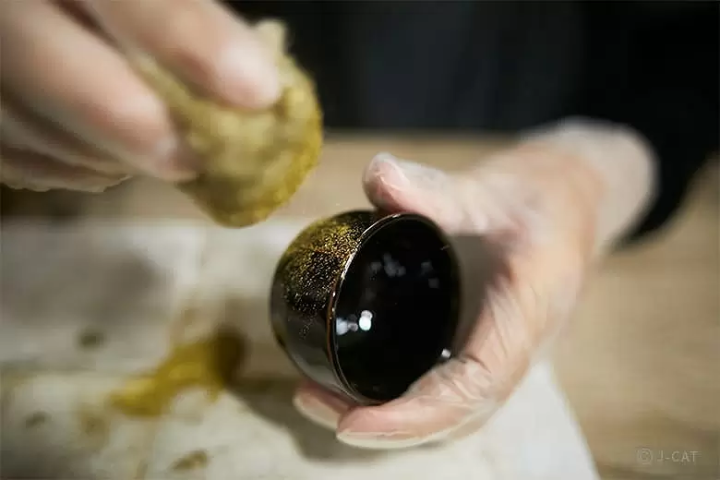
Picture courtesy of Wabunka
Situated in Kyoto's Shijo-Kawaramachi district, Shikata Kizou Urushi is a specialized Japanese lacquerware shop that has been operating since 1867. The shop's authentic lacquer, known as urushi, is derived from the sap of the Japanese Sumac tree and is entirely crafted and processed by artisans from start to finish.
In this beautifully inclusive workshop, guests learn both hands-on expert techniques and interesting facts and history from a specialized artisan, gaining a better insight into this ancient craftsmanship.
Through the process of kintsugi, participants select a damaged ceramic piece that resonates with them the most, reviving the pottery by binding the fragments together with metallic powder and painting delicate gold pathways over the top, creating a precious memento of their time spent in Japan.
↑ Return to the top of article.
2. The Art of Making Japanese Traditional Confections, Taught by a Kyoto Artisanal Confectioner

Picture courtesy of Wabunka
Tokiya is a Kyoto confectionery shop located in Kamigyo ward, an area that is convenient for those visiting famous destinations such as Nijo Castle and the Kyoto Imperial Palace.
Participants are swept into the rich world of Kyoto-style confectionery, learning how Japan's four seasons and Kyoto aesthetics combine to create beautiful seasonal Japanese traditional sweets!
In this experience, visitors can delve into professionally made sweets and matcha green tea, as well as an interactive lesson on making their wagashi souvenirs to take home. Guests are introduced to the principles of Kyoto's aesthetic sweets, the symbolism of color and its importance, tools, and more.

Picture courtesy of Wabunka
A top confectionery artisan will also offer a Kinton-making demonstration. Kinton is a crumbly sweet made from sweet bean paste; this confection is made to match the themes and colors of the Japanese calendar.
Once the sweets are made, the artisan will also teach you how to pack the delights. At the end of the session, the participants will enjoy tea and sweets as they chat with the artisan over a snack.
↑ Return to the top of article.
3. Private Kimono and Tea Ceremony Experience at a Machiya Townhouse in Kyoto

Picture courtesy of Wabunka
Nishijin Lifestyle Museum Tondaya, situated in a historical old townhouse called machiya, is the perfect place to experience a tea ceremony wearing a kimono. Located in Nishijin, Kyoto's famous textile district, this machiya offers a rich taste of Kyoto's charming history and high-quality silk fabrics.
Participants are invited to an elegant evening of beauty and craftsmanship as they dress in one-of-a-kind and rare kimono, learn about the local history, and unwind with a tea ceremony in this nationally registered tangible cultural property.
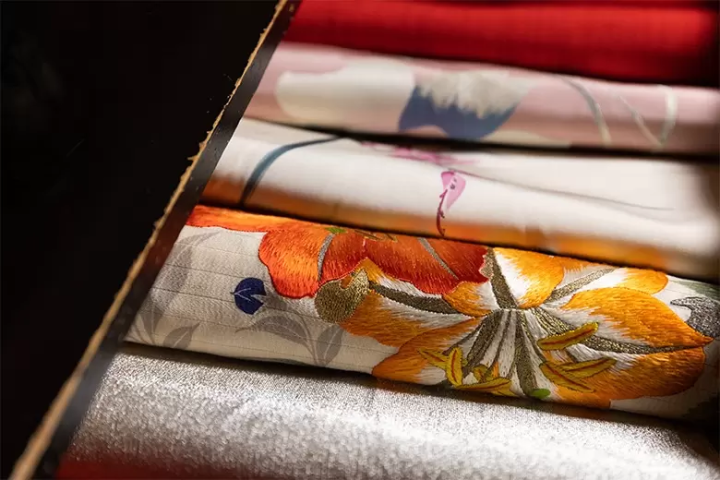
Picture courtesy of Wabunka
Renowned for its high-quality textiles and craftsmanship, Nishijin is a kimono lover's dream! Creating elegant and intricate fabrics, this district has become famous for its unique and complex crafting techniques so much so that the fabric created in the town is often referred to as Nishijin-ori ("Nishijin textiles").

Picture courtesy of Wabunka
Ms.Tanaka, the property's 13th-generation owner and a kimono expert, guides guests through the precedents of the house showcasing irreplaceable, rare, and unique items.
Tondaya is an incredible structure with three tea houses, gardens, and even a Noh theater performance room surrounded by pine trees! The tour around the building gives a fantastic insight into Japanese history, culture, and architecture.
The host will assist visitors in selecting styles, colors, and fabrics that enhance their natural beauty. Wearing stunning kimonos and obi from the establishment's exquisite assortment of silk garments, participants will enjoy a tea ceremony, savoring delectable, velvety matcha tea and authentic Japanese confections, all while delving deeper into the legacy of this ancient art form.
↑ Return to the top of article.
4. Incense Making Experience with Tea Ceremony in Uji, Kyoto
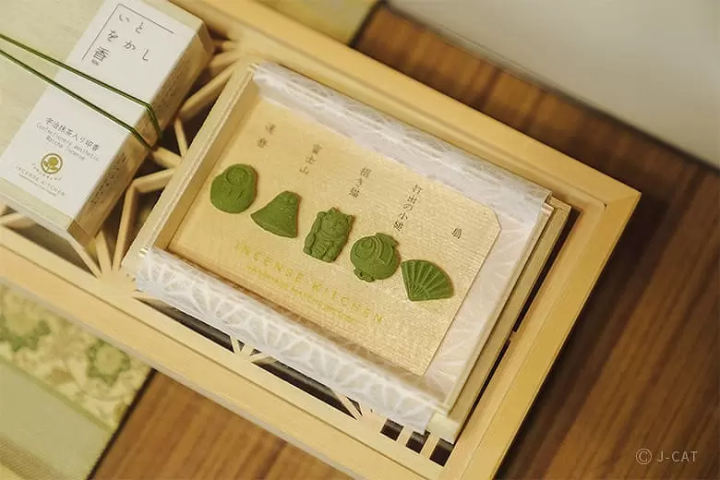
Picture courtesy of Wabunka
The town of Uji, located south of Kyoto, is renowned for its high-quality green tea. Visitors can enjoy here a unique incense-making experience hosted by the ancient Agata Shrine.
Participants are guided to a serene chamber nestled within the lush inner garden of the main shrine, where the alluring fragrance of premium matcha welcomes them. Here, Ms. Kyoko Goto, a seasoned incense artisan and the founder of Incense Kitchen, will share stories about Uji's tea and incense-making traditions, unveiling the art's techniques and tools with grace and expertise.
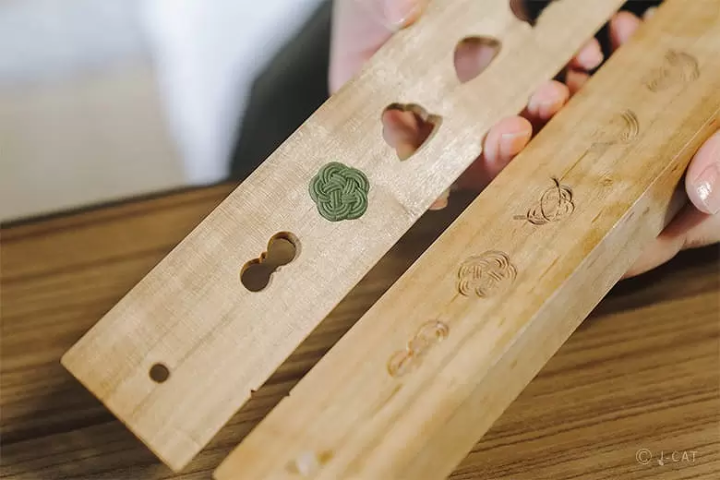
Picture courtesy of Wabunka
The matcha green tea incense is meticulously crafted using a wooden block traditionally employed in confectionery making, embellished with seven molds, each intricately designed with symbols and art reflective of Uji. Using these adorable molds, participants will craft lovely fragrant keepsakes.
Guests will also enjoy exquisite local tea and delectable seasonal treats! The Green Tea Experience, tailored to the time of year, presents a diverse selection of flavored teas, vibrant ceramic tea bowls, confections, and brewing methods curated to suit the season.
This serene interlude not only enriches a Kyoto itinerary but also immerses visitors in the historical cultural tapestry and iconic landmarks of Kyoto.
↑ Return to the top of article.
5. Dye a Silk Scarf or Handkerchief with Seasonal Plants at Atelier Shimura Kyoto
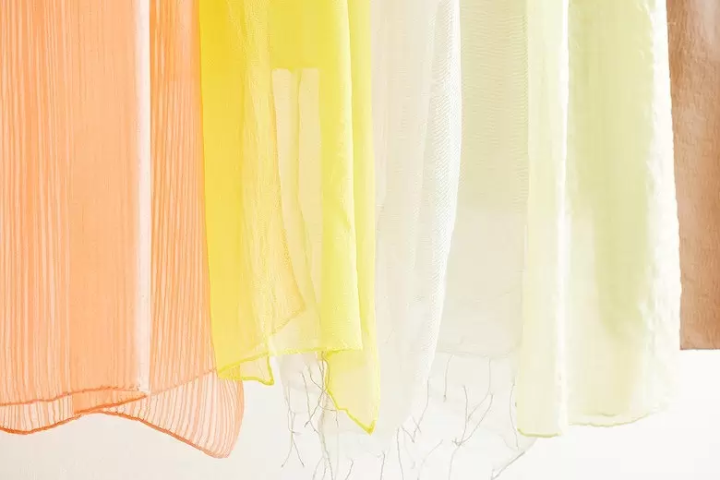
Picture courtesy of Nobuto Osakabe
Atelier Shimura is a prestigious establishment committed to the age-old craft of dyeing textiles, with a particular focus on kimono textiles, utilizing natural hues extracted from Japanese flora and plants. This facility follows in the footsteps of Fukumi Shimura, Kyoto's renowned dyer and weaver.
This workshop offers an exclusive and environmentally mindful journey, where guests can immerse themselves in deying textiles using a selection of seasonal flowers such as cherry blossoms, madder root, and others.
Every workshop session and the dyed items produced here are intricately tied to the season's bounty, the time of the year, and the distinctive soil nurturing the plants, resulting in truly exceptional and individualized mementos.
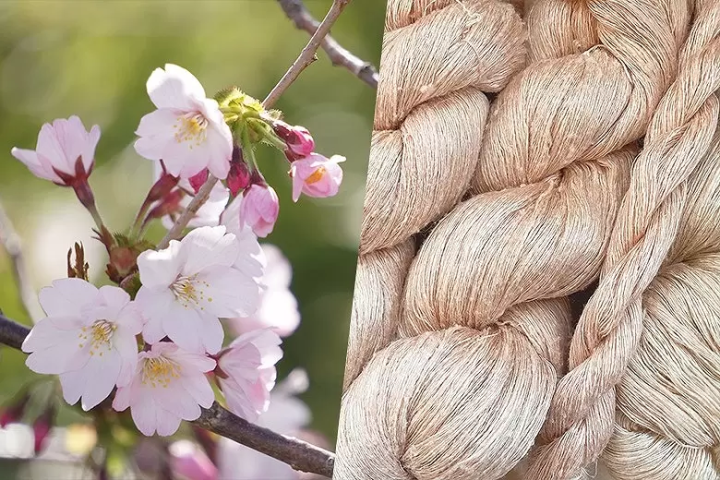
Picture courtesy of Wabunka
Guests will delve deep into the delicate craft of fabric dyeing from immersing silk in dyed water and observing the gentle touch of the sun enhancing the colors, to the subsequent drying and repeated dyeing. Each stage shows the vibrant metamorphoses in the fabric's shades.
The culmination is especially striking when the scarves are set in a definitive solution infused with an assortment of minerals to lock in the dye. Visitors witness the sun infuse vitality into their distinct creations, and will have the pleasure of carrying their exclusive keepsake home on the same day!
↑ Return to the top of article.
6. Kyoto-Style Kawara Roof Tiles: Private Tour of Asada Kawara Factory
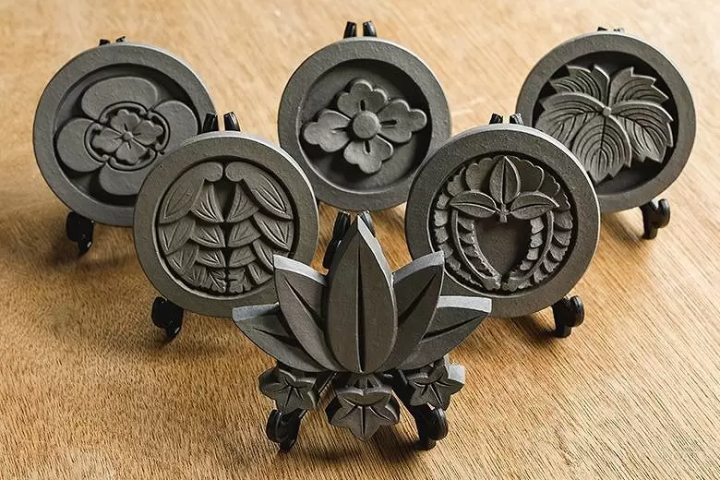
Picture courtesy of Wabunka
Japan is celebrated for its architecture, ranging from historic residences to sacred shrines and temples, with one of the most enchanting elements being the elaborate roof tiles that grace the summits of these structures. Kawara tiles often showcase clan insignias and deities, serving as protective emblems for households, temples, and various edifices.
At the Asada Kawara Factory, participants delve into this time-honored artistry as expert craftsmen meticulously fashion flawless pieces in traditional kilns, maintaining the legacy of the last remaining factory of its kind in the vicinity. This ancient practice of handcrafting intricate tiles was introduced to Japan approximately 1,400 years ago and continues to profoundly influence the captivating landscape of Japanese architecture to this day.
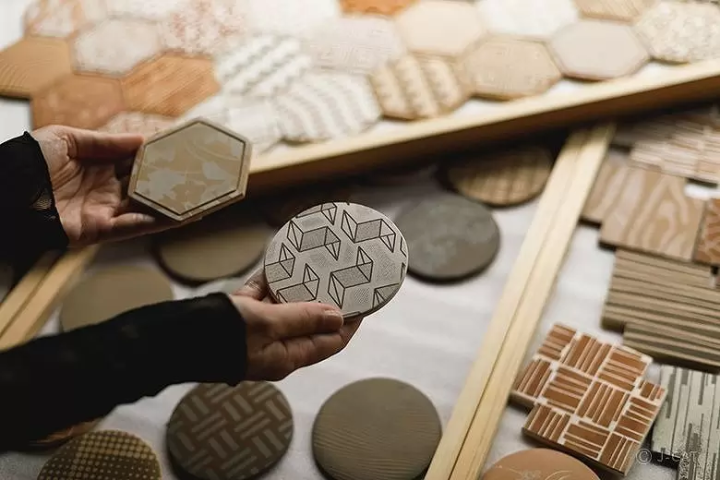
Picture courtesy of Wabunka
Renowned for their superior craftsmanship, Kyo-gawara tiles originating in Kyoto are esteemed for their refined and skillfully executed surfaces. Upholding this legacy, Mr. Masahisa Asada, the third-generation leader of the factory, extends a warm invitation to enthusiasts, immersing them in the realm of this distinctive art form.
During his engaging tours, Mr. Asada shares age-old anecdotes of deities, mythological tales, and the rich historical tapestries of Japanese and Chinese lore that often adorn these tiles. This experience offers a fascinating insight into a facet of Japan deeply intertwined with the construction of iconic and prestigious structures.
Participants have the opportunity to select their very own Kyo-gawara souvenir in the form of a tile coaster embellished with exquisite traditional patterns. Those eager to delve deeper into the craft can opt for an additional fee, partaking in a hands-on session guided by Mr. Asada himself, where they can create their own Kyo-gawara coaster, learning the time-honored techniques along the way.
↑ Return to the top of article.
7. Make Japanese Sweets with Demonstration at Wagashi Issho, Kyoto
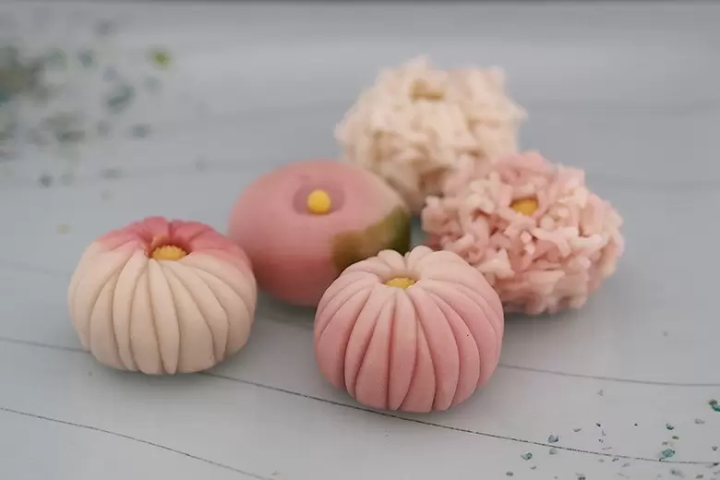
Picture courtesy of Wabunka
Indulge in the art of making delicate Japanese sweets at Wagashi Issho, nestled in the heart of Kyoto’s Shijo Karasuma district. This studio, led by esteemed wagashi artisan Yasue Miyazaki, offers a unique opportunity to immerse yourself in the world of traditional Japanese confections.
At Wagashi Issho, participants create exquisite wagashi in small-group classes, a coveted experience that even locals find challenging to secure. Under the expert guidance of Ms. Miyazaki, guests delve into the craftsmanship of preparing original desserts, all while basking in the elegance of the space and the artistry involved in this refined culinary tradition.
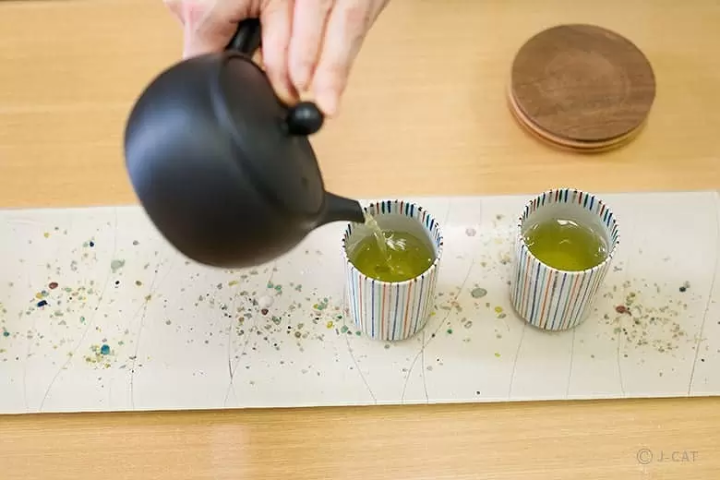
Picture courtesy of Wabunka
Participants will be introduced to the delicate artistry behind nerikiri, a confection inspired by the exquisite chrysanthemum flower—a symbol deeply ingrained in Japanese heritage.
Under Ms. Miyazaki's expert guidance, guests craft these elegant delicacies using authentic wagashi implements and premium ingredients. Upon completion, the confections are savored alongside the fine Uji green tea sourced from the renowned and award-winning Rishoten tea shop.
Participants receive the recipe used during the workshop, enabling them to recreate these delectable treats in the comfort of their homes and share the joy with loved ones while cherishing the memories of their time spent learning this exquisite craft.
↑ Return to the top of article.
8. Kimono Workshop and Bridal Kimono Hands-on Experience
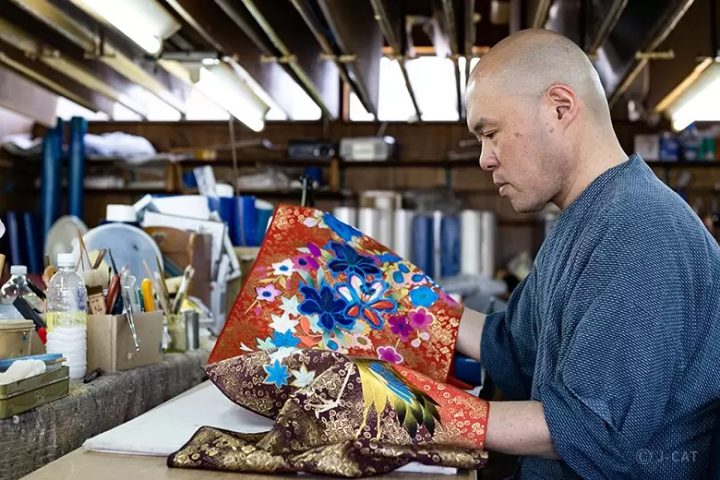
Picture courtesy of Wabunka
Miyake Kougei is a renowned workshop specializing in uchikake, traditional bridal kimonos. Established by Nobumi Miyake, a skilled artisan proficient in Kyo-yuzen hand-painting and gold glaze techniques, the workshop houses a select group of highly trained artisans dedicated to producing meticulously crafted kimonos.
During your visit, you will witness a demonstration showcasing the primary steps involved in applying gold glaze and mother-of-pearl inlays, a glimpse into the elaborate process of creating a kimono that spans nearly 20 meticulous steps.
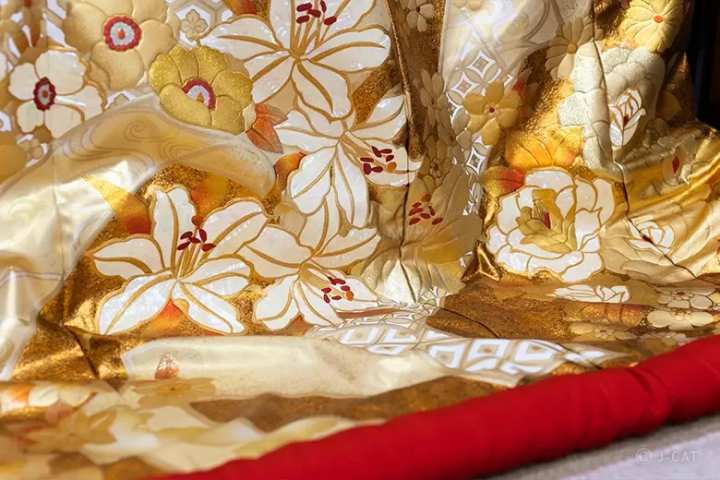
Picture courtesy of Wabunka
You'll also visit the newly constructed gallery exhibiting breathtaking uchikake designs and exclusive artworks not typically available to the public.
Following the tour, immerse yourself in a hands-on experience where you will create your unique fabric by applying gold glaze to a postcard-sized uchikake fabric piece. Guided by Mr. Miyake, you will choose a favorite design from seasonal flower patterns and delve into essential gold glazing techniques such as the art of applying gold leaf, softening powdered gold, and delicately dusting the powder onto your chosen floral motif.
↑ Return to the top of article.
9. Gild Your Own Maneki-Neko and Postcard With Gold Leaf in a Kyoto Suite

Picture courtesy of Wabunka
Indulge in the craft of Japanese gilding in a refined setting provided by Hotel Kanra Kyoto, which is just a short 15-minute walk from Kyoto Station. In this experience, you'll discover the uses of genuine gold leaf as you embark on crafting a postcard and a maneki-neko (a beckoning cat figurine).
The production of gold leaf demands masterful expertise; initially, skilled artisans fuse bars of gold with a tiny proportion of silver or bronze, meticulously hammering the amalgam into an ethereal sheet with a thickness measuring just one ten-thousandth of a millimeter. Apart from its use in temples, shrines, and fine arts and crafts, gold leaf is also used as a delicate food garnish.
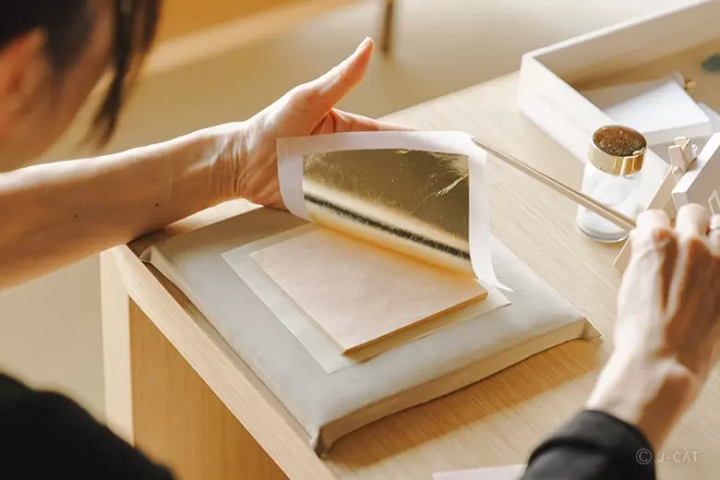
Picture courtesy of Wabunka
For your creations, you'll select from a diverse array of Kyoto-themed designs for your postcard, each serving as a memento of your unforgettable time in this historic city. The maneki-neko, a symbol of luck and prosperity, promises to continue bringing good fortune even long after you've returned home, making it an ideal keepsake from your journey.
Cap off this enriching experience by delighting your senses with an elegant afternoon tea showcasing a delectable assortment of Japanese and Western desserts, complemented by seasonal fruits and traditional teas, all enjoyed within the comfort of the same exquisite suite.
Engage in a journey that seamlessly blends artistry, tradition, and culinary delights, offering a truly immersive taste of Kyoto's cultural richness.
↑ Return to the top of article.
10. Kiyomizu Ware Pottery Experience at a Century-Old Kiln near Kiyomizudera Temple
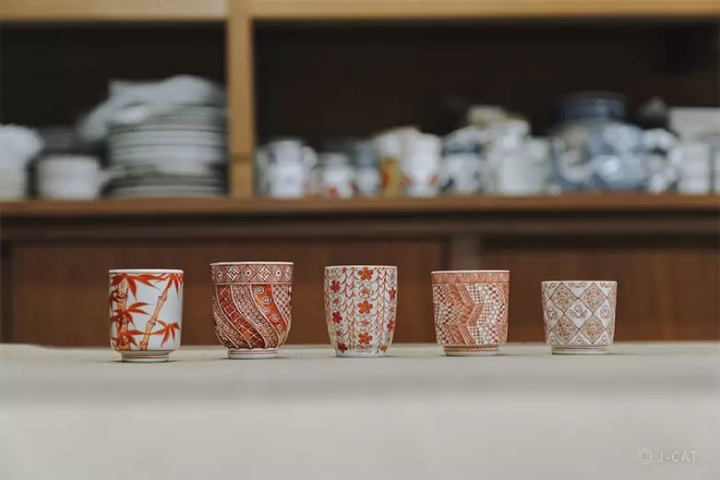
Picture courtesy of Wabunka
Established over a century ago near the iconic Kiyomizudera Temple, Shoukoku Kiln is renowned for producing fine ceramic tableware favored by upscale ryotei restaurants specializing in refined Kyoto cuisine.
This experience is a chance to unravel the mysteries behind creating enduring, premium ceramics. You'll engage in the art of hand-building or painting pottery under the tutelage of a seasoned artisan well-versed in the intricate techniques of Kyo-yaki and Kiyomizu-yaki ceramic craftsmanship.
At the end, you'll enjoy wagashi sweets and matcha green tea served in a bowl created by Shoukoku Kiln.
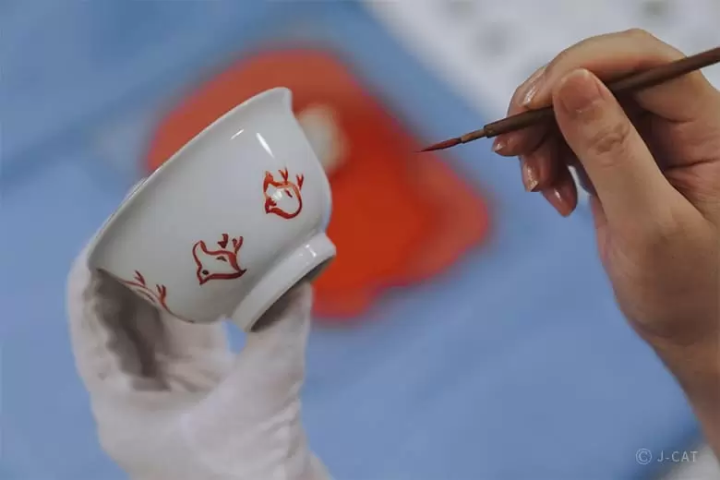
Picture courtesy of Wabunka
Following this, you'll witness the skilled utilization of an electric potter's wheel—an intimate glimpse into the artisans' masterful techniques. You'll be offered a plate to inscribe with your name and date or design of your choosing, imbuing it with a unique and personal flair.
To wrap up your immersive experience, unwind in style by relishing seasonal wagashi sweets sourced from esteemed Kyoto establishments, paired harmoniously with a soothing bowl of matcha green tea. Crafted with precision and care, the very bowl that cradles your matcha is none other than a creation of the esteemed Shoukoku Kiln.
↑ Return to the top of article.
11. Craft a Charming Journal with Traditional Handmade Washi Paper
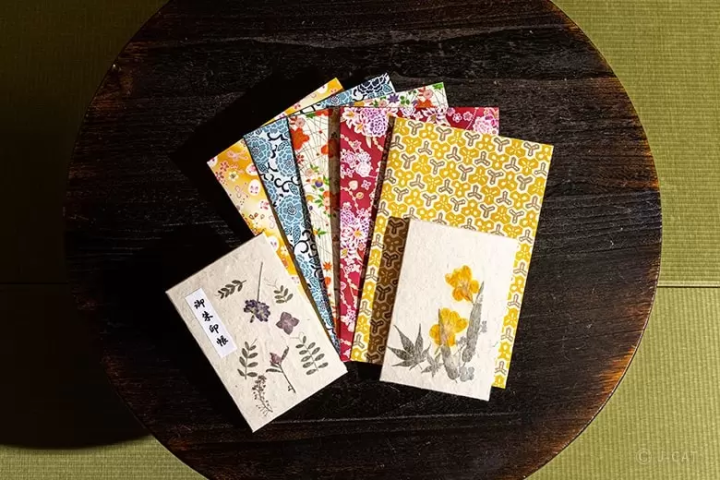
Picture courtesy of Wabunka
Kamitowa is one of Kyoto's distinguished Japanese washi paper specialty shops. Immerse yourself in the rich heritage of paper craftsmanship at their workshop, where you will craft a personalized temple-stamp journal using techniques that span back 14 centuries.
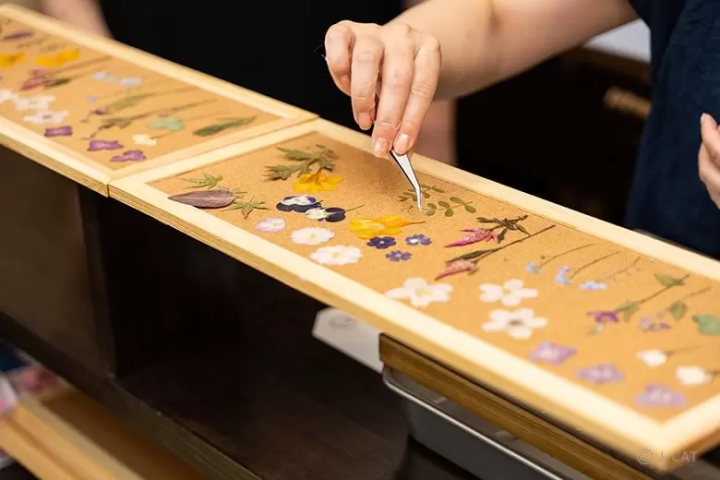
Picture courtesy of Wabunka
As part of the experience, you will engage in crafting authentic washi paper. Utilizing the handmade washi, you will create a unique journal adorned with a pressed flower design.
You can use this special journal as a travel diary or a dedicated temple stamp book, allowing you to carry your memories with you from the experience. Enjoy the charm of washi paper and the satisfaction of making it with your own hands at Kamitowa!
↑ Return to the top of article.
12. Authentic Tea Ceremony with Exclusive Treats from a Historical Kyoto Confectioner
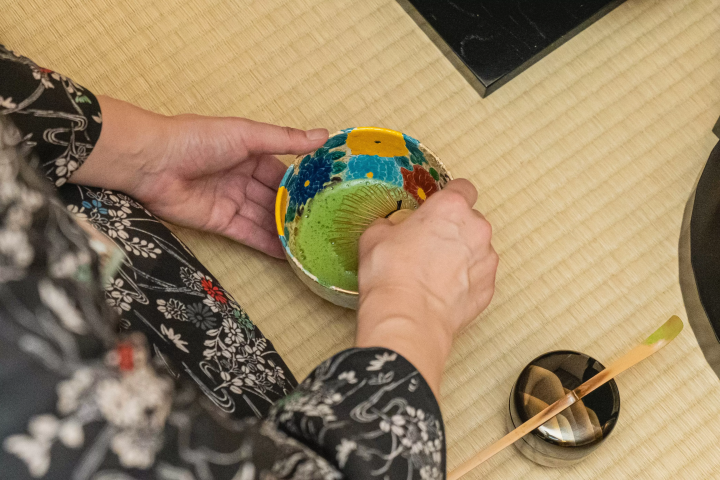
Picture courtesy of Wabunka
Sasaya-iori is a renowned Kyoto confectionery workshop with a history of over 300 years.
This tea ceremony experience takes place in its authentic villa annex tearoom, where you'll learn the basic manners of tea ceremony and enjoy matcha and traditional confections exclusive to this experience.

Picture courtesy of Wabunka
Following this enriching session, participants will indulge in a sumptuous parfait or mamekan agar jelly at the contemporary tearoom-fusion counter. This unique encounter presents a rare chance to delve into the profound essence of Japanese culture through the harmonious blend of tea ceremony customs and exquisite sweets.
↑ Return to the top of article.
Experience Japanese Culture in Kyoto
While exploring Japan, one encounters numerous exciting activities, places, and foods to experience. However, it is equally significant and special to interact with a skilled artisan who can offer insights into Japanese culture, traditions, and history!
These one-of-a-kind experiences are sure to become cherished memories. By immersing in traditional crafts, exploring history, and crafting souvenirs, participants acquire unique stories to share for years to come.
Read also
Main image courtesy of Wabunka
Assistant editor at MATCHA since 2023, Kate is a photographer who enjoys traveling Japan's hidden gems and adventuring off the beaten path. Living in Japan since 2018, she has traveled across different areas of Japan. From indulging in Aomori’s apple pies and fiery festivals to exploring the quaint charm of Nagasaki’s cat-filled streets she is always searching for new areas full of atmospheric beauty, festivals, and seasonal events to capture on camera.





































![[Coupon Available] Attention Overseas Winter Sports Fans! Nagano's Sports Depot Has Evolved](https://resources.matcha-jp.com/resize/720x2000/2026/01/05-254819.webp)
![[2 hours from Tokyo ] 10 Quiet and Breathtaking Views of Mount Fuji in Yamanashi Hokuto City , Yamanashi - Part 2](https://resources.matcha-jp.com/resize/720x2000/2025/12/16-253037.webp)
